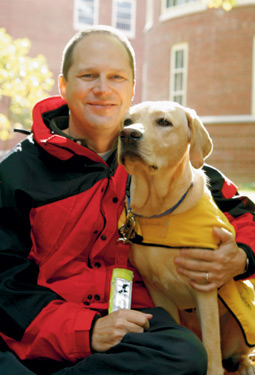She stays with me in hotels, trying to sneak onto the bed in the middle of the night, occasionally putting a partially chewed hoof in my mouth while I’m asleep.
 Our home has been filled with the patter of little feet—four of them—for the past‑few years. My partner, Brian, and I have nearly finished raising‑our‑third guide dog, a wonderfully‑fun and‑peaceful‑10-month-old‑yellow Labrador Retriever named‑Sarah—predestined for a life of service.
Our home has been filled with the patter of little feet—four of them—for the past‑few years. My partner, Brian, and I have nearly finished raising‑our‑third guide dog, a wonderfully‑fun and‑peaceful‑10-month-old‑yellow Labrador Retriever named‑Sarah—predestined for a life of service.
When we lived in New Hampshire, we responded to an article in the local paper asking for host families to apply for the "puppy walker" program‑of the Guide Dog Foundation. A few weeks later, we picked up a very sleepy, 10-week-old bundle of Labrador, and our Guide Dog journey started. Riley, our first, has successfully graduated and is now guiding a gentleman in Massachusetts;‑Babs, our second, is guiding a student at the University of Montana.
The Foundation’s goal for the first year is to provide a broad base of experiences for the puppy. Guide dogs must be fearless while not being aggressive, and the more things they are exposed to in the first year, the less likely they are to be startled as they continue their training. Simple‑activities, such as‑carrying her while vacuuming, letting her meet clowns (not always easy for many humans!), watching parades and fireworks shows and football games, walking near traffic, and meeting other neighborhood pets all contribute to success. Sitting on the corner near taxis and other cars in Manhattan, hanging out with the toys in a store at the mall and watching the children playing, and visiting grocery stores are all part of the socialization process.
The real fun, however, comes when traveling with her. I spend many days on the road in my work for IBM, and much of that time I am accompanied by‑my puppy. Thanks to most people’s desire to help in her training (Sarah wears a smart yellow vest that identifies her as a future guide dog), I’ve never had trouble taking her anywhere I have gone. She flies curled on my feet in a bulkhead row on the airplane, usually sleeping through takeoffs and landings. She sleeps‑(often on her back) in the‑front passenger footwell of the car, or lays quietly next to me on the train, the subway, or the bus.
Sarah stays with me in hotels, trying to sneak onto the bed in the middle of the night, occasionally‑putting a partially chewed hoof in my mouth while I’m asleep. She sits under the table in restaurants, accompanies me to meetings, and sits quietly next to the podium when I am presenting.‑(One of my customers made our previous guide dog puppy, Babs, her own ID badge, complete with picture and pawprint signature.)
Wearing her yellow vest also lets Sarah know that she is "on the job" (much as her wearing a harness will be a signal in her working life). Though she’s as fun-loving as any puppy, she quickly learned‑not to play, eat, or relieve‑herself while‑wearing the vest. But when she’s off the clock, she runs, jumps, and plays with our other Labrador‑(and the guinea pig). On our recent trip to Wabash College for a meeting at the Center of Inquiry in the Liberal Arts, she learned (and I was reminded) how much fun a pile of leaves in the Fuller Arboretum can be.
If there is any downside to having her, it is that seemingly mundane tasks in public take‑a little bit longer than usual because everyone wants to know all about her and how the program works.
After‑a year‑(or so) of living with us, most of the puppies start‑their formal training‑back at the Guide Dog Foundation. She will need to pass several tests to become a guide dog. An instructor will fire off a‑starter’s pistol as she walks by: she can look, but if she‑startles, she’s out of the program. She’ll have to learn to walk on escalators and in revolving doors (things we can’t teach her, since the‑procedures for her to navigate them are quite specific and she could‑injure her paws in either). She’ll have to show that she knows what to do at‑obstacles, stairs,‑and crosswalks, and that she’s ready to be trusted‑to guide someone in‑a fast-moving world.
Only then will she be matched with a blind person, who will be flown, housed, and fed, at the Guide Dog Foundation’s expense, for a 25-day training course with the dog. We get invited to graduation to watch them cross the stage together. Sarah then starts her working life, and she can retire with us when she’s done. We figure we’ll‑start a home for geriatric Labradors in about‑eight years.
To say we’ll miss‑Sarah is an understatement, but we‑have prepared ourselves‑from the time we’ve received each of these puppies by remembering that we’re just taking care of someone else’s dog for a year, and helping that dog prepare for their extraordinary life together.
But we will pick up‑our next puppy‑the‑moment we turn‑Sarah in;‑one can’t be sad for too long while running around the house with a roll of paper towels.
Rob Shook is director of worldwide marketing at IBM. He and Brian are currently raising a new guide dog puppy, Chivas, who thus far is getting along well with the guinea pig.
Learn more about the guide dog program at www.guidedog.org